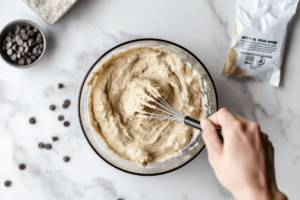How to Add Protein to Box Muffin Mix: A Complete Guide
Why Add Protein to Box Muffin Mix?
Benefits of Protein-Enriched Muffins
Adding protein to box muffin mix isn’t just a trend—it’s a smart way to elevate your baking game. By adding protein, you transform regular muffins into a snack that fuels your body with energy while keeping hunger in check. These muffins are versatile, offering benefits to everyone—from fitness enthusiasts to busy parents or anyone looking for healthier snack options.
High-protein muffins help you feel full longer, reduce unhealthy snacking, and keep your energy stable throughout the day. Plus, they’re perfect for various diets, like keto, vegan, or gluten-free. So, you’re not just making muffins—you’re creating balanced, wholesome treats!
The Role of Protein in Baking
Protein powder doesn’t just enhance nutrition—it’s also critical for structure and texture in baked goods. Proteins in baking act as a binding agent, ensuring your muffins hold their shape. However, using protein powders comes with a learning curve, as too much can lead to dense or dry results.
The best powders for baking are heat-stable options like whey, pea, or casein, which maintain their nutritional value during cooking. Using the right kind is crucial to achieving that perfect fluffy texture. For more insights, check out these protein powder baking tips.
Preparing to Add Protein to Box Muffin Mix
Choosing the Right Protein Powder
Not all protein powders are created equal, and selecting the right one is crucial when adding protein to a box muffin mix. You’ll want a powder that blends well, complements the muffin’s flavor, and holds up to baking temperatures.
- Whey Protein: This is the most popular choice because of its light texture and ability to dissolve easily. Whey works well with most muffin flavors, such as vanilla, chocolate, and blueberry.
- Plant-Based Protein: If you’re looking for a vegan option, pea, rice, or soy protein are excellent choices. These powders can be slightly denser, so you may need to add a bit more liquid to your mix.
- Unflavored Protein Powder: Perfect for when you want the muffin’s natural flavor to shine through. You can always add vanilla or almond extract to enhance the taste.
Choosing a heat-stable powder is key, as some protein powders lose their quality when exposed to high temperatures. For best results, consider how the powder’s flavor and consistency will pair with your muffin mix.
Adjusting Other Ingredients
When you add protein powder to the muffin mix, you’ll need to tweak a few other ingredients to ensure the muffins bake properly. Adding protein can sometimes thicken the batter, so balance is critical.
- Moisture Matters: Protein powder absorbs liquid, so you may need to add extra milk, water, or oil to prevent the muffins from becoming dry. Aim to adjust the liquid by one tablespoon at a time.
- Sweetness Levels: Protein powders, especially flavored ones, can alter the sweetness of the muffins. If you’re using an unsweetened powder, consider adding a natural sweetener like honey, maple syrup, or stevia to balance the flavor.
- Fat and Texture: If the muffins feel too dense, try adding an extra egg or a bit more oil to the batter for fluffier results.
Pre-Baking Tips for Success
Preparation is the key to nailing protein-packed muffins! Before diving in, follow these tips to ensure your muffins come out perfectly.
- Test in Small Batches: If this is your first time adding protein to muffins, start with a small amount of protein powder to avoid overloading the batter.
- Mix Thoroughly: Use a whisk or sifter to ensure the protein powder blends evenly. Clumps can lead to uneven baking or pockets of powder in the final product.
- Don’t Overmix: While it’s tempting to stir until perfectly smooth, overmixing can make your muffins tough. Gently combine ingredients until just incorporated.
With the right protein powder and ingredient adjustments, you’re ready to mix, bake, and enjoy muffins that are both delicious and nutrient-packed! Up next, let’s dive into a step-by-step guide on how to add protein to your muffin mix successfully.
How to Add Protein to Box Muffin Mix (Step-by-Step Guide)
Step 1: Gather Your Ingredients
Before you begin, make sure you’ve got all the essentials. Here’s what you’ll need:
- A box of muffin mix (your choice of flavor).
- Your preferred protein powder (whey, plant-based, or unflavored).
- Extra wet ingredients: milk, water, or oil (to balance the added protein).
- Optional add-ins like nuts, seeds, or fruit for extra texture and flavor.
- Measuring cups, a whisk, and a mixing bowl.
Gathering everything upfront helps you avoid mid-recipe chaos. Plus, it ensures you can focus entirely on nailing that perfect muffin batter!
Step 2: Determine the Protein Ratio
Adding protein powder to the muffin mix is all about balance. Too much protein can make your muffins dense, while too little won’t deliver the health benefits you’re looking for.
A general rule of thumb is to add 1 scoop of protein powder per cup of dry muffin mix. If your box calls for two cups of mix, add two scoops of protein powder. This ratio works well to preserve the muffin’s texture while boosting its nutritional value.
Pro tip: If you’re unsure, start small. You can always increase the protein content in future batches!
Step 3: Mix the Ingredients Properly
When mixing, the order in which you combine ingredients matters. Here’s how to do it right:
- Combine Dry Ingredients First: Add the protein powder to the muffin mix and whisk thoroughly. This ensures the protein powder is evenly distributed and prevents clumping.
- Add Wet Ingredients Gradually: Follow the instructions on the box, but don’t hesitate to add a bit more milk, water, or oil as needed. Protein powder tends to absorb moisture, so keep an eye on the consistency.
- Mix Gently: Overmixing can lead to tough muffins. Stir just until all ingredients are combined, and the batter looks smooth.
Step 4: Adjust Consistency and Taste
Once your batter is mixed, it’s time to make any last-minute tweaks. Is the batter too thick? Add a splash of milk or water until it reaches the desired consistency.
Don’t forget to do a quick taste test before baking! If the batter seems bland, you can enhance the flavor with vanilla extract, cinnamon, or a dash of nutmeg.
Step 5: Bake and Enjoy
Follow the baking instructions provided in the muffin mix box. However, keep in mind that adding protein may slightly alter the baking time.
- Check Early: Protein-enriched muffins can bake faster, so start checking for doneness a few minutes before the recommended time. Insert a toothpick into the center; if it comes out clean, your muffins are ready!
- Cool Completely: Once baked, allow the muffins to cool on a wire rack. This helps them set and prevents a gummy texture.
And that’s it—you’ve successfully added protein to the box muffin mix! Now you’ve got a batch of muffins that are as delicious as they are nutritious. Let’s explore more ways to incorporate protein into your muffins beyond just powders in the next section.
Protein Additions Beyond Powder
Alternative Protein Sources
While protein powder is the go-to option, it’s not the only way to add protein to your box muffin mix. Sometimes, whole food ingredients can provide both protein and additional flavor or texture. Here are some excellent alternatives:
- Greek Yogurt: Adding a dollop of Greek yogurt increases the protein content while making the muffins moist and creamy. Replace some of the liquid in the recipe with yogurt to get the best results.
- Nut Butters: Peanut butter, almond butter, or sunflower seed butter not only add protein but also bring a rich, nutty flavor to your muffins. Stir a few tablespoons into the batter or drizzle on top before baking.
- Chia Seeds or Flaxseed Meal: These tiny superfoods pack a punch of protein and fiber. Sprinkle a few teaspoons into the mix for added nutrition and a slightly nutty flavor.
- Cottage Cheese: Blending cottage cheese into the batter can boost protein while adding a velvety texture. Its mild flavor works well in sweet or savory muffins.
Incorporating Whole Foods for More Protein
If you’re feeling adventurous, you can incorporate whole foods into your muffin mix for a natural protein boost. These options work great if you want to keep things simple or avoid processed powders:
- Nuts and Seeds: Chopped almonds, walnuts, pecans, or pumpkin seeds not only add crunch but also increase the protein content. Toss a handful into the batter or sprinkle them on top for a decorative touch.
- Cooked Quinoa: Quinoa is a complete protein and blends surprisingly well into muffin batter. Make sure it’s fully cooked and cooled before folding it into the mix.
- Rolled Oats: While oats are known for their fiber content, they also add a decent amount of protein. Use quick oats for smoother muffins or rolled oats for a heartier texture.
- Shredded Coconut: Unsweetened coconut flakes contribute a subtle flavor and texture along with some plant-based protein.
Creative Combinations
Why settle for just one protein source when you can mix and match? For instance, you can combine whey protein powder with Greek yogurt or add chopped nuts and a scoop of protein powder. These combinations allow you to experiment with flavors and textures while maximizing the protein content.
Protein-Packed Muffin Recipes and Variations
Now that you know how to add protein to box muffin mix, let’s dive into some delicious recipes and variations to inspire your baking. Whether you’re craving something sweet, savory, or diet-specific, these ideas will help you create muffins that are both nutritious and satisfying.
1. Classic Chocolate Protein Muffins
Ingredients:
- 1 box chocolate muffin mix
- 1 scoop chocolate whey protein powder
- 1/4 cup Greek yogurt (optional, for extra moisture)
- 1/4 cup milk (adjust as needed)
- 1/4 cup dark chocolate chips (optional)
Instructions:
- Preheat the oven according to the muffin mix instructions.
- In a mixing bowl, combine the muffin mix and protein powder.
- Add the wet ingredients (Greek yogurt, milk, and eggs) and mix until just combined.
- Fold in the chocolate chips if using.
- Pour the batter into muffin cups and bake as directed.
Pro Tip: For a richer flavor, use almond milk or add a teaspoon of instant coffee to the batter.
2. Blueberry Almond Protein Muffins
Ingredients:
- 1 box vanilla muffin mix
- 1 scoop vanilla or unflavored protein powder
- 1/4 cup almond butter
- 1/4 cup unsweetened almond milk
- 1/2 cup fresh or frozen blueberries
- 2 tablespoons sliced almonds (for topping)
Instructions:
- Preheat the oven and prepare the muffin tin.
- Mix the muffin mix and protein powder in a bowl.
- Add almond butter, almond milk, and eggs, and stir until combined.
- Gently fold in the blueberries.
- Divide the batter into muffin cups and sprinkle sliced almonds on top.
- Bake as directed on the box.
Pro Tip: Swap blueberries for raspberries or diced strawberries for a fruity twist.
3. Savory Spinach and Cheese Protein Muffins
Ingredients:
- 1 box cornbread muffin mix
- 1 scoop unflavored or savory protein powder
- 1/2 cup cooked quinoa (optional)
- 1/2 cup chopped spinach
- 1/4 cup shredded cheddar cheese
- 1/4 cup milk or water
Instructions:
- Preheat the oven and prepare the muffin tin.
- Combine the muffin mix, protein powder, and quinoa in a bowl.
- Add the wet ingredients and mix until just combined.
- Fold in the spinach and cheese.
- Pour the batter into muffin cups and bake as directed.
Pro Tip: Add diced cooked bacon or sun-dried tomatoes for extra flavor.
4. Keto-Friendly Protein Muffins
Ingredients:
- 1 box keto muffin mix (or almond flour-based mix)
- 1 scoop keto-friendly protein powder (e.g., collagen or whey isolate)
- 1/4 cup unsweetened almond milk
- 1/4 cup coconut oil (melted)
- 1/4 cup sugar-free chocolate chips or nuts
Instructions:
- Preheat the oven and prepare the muffin tin.
- Mix the muffin mix and protein powder in a bowl.
- Add almond milk, coconut oil, and eggs, and stir until combined.
- Fold in the chocolate chips or nuts.
- Bake according to the mix instructions.
Pro Tip: Use monk fruit or stevia as a sweetener if the batter needs more sweetness.
5. Vegan Banana Protein Muffins
Ingredients:
- 1 box banana muffin mix
- 1 scoop plant-based protein powder (vanilla or unflavored)
- 1/4 cup mashed ripe banana
- 1/4 cup almond milk
- 1 tablespoon flaxseed meal (mixed with 3 tablespoons water, as an egg substitute)
Instructions:
- Preheat the oven and prepare the muffin tin.
- Combine the muffin mix and protein powder in a bowl.
- Add the mashed banana, almond milk, and flaxseed mixture.
- Mix until just combined.
- Pour the batter into muffin cups and bake as directed.
Pro Tip: Add a handful of chopped walnuts or pecans for extra crunch.
Storing and Serving Protein Muffins
Once your muffins are baked to perfection, proper storage ensures they stay fresh and delicious.
- Room Temperature: Store muffins in an airtight container for up to 2 days.
- Refrigerator: For longer storage, keep them in the fridge for up to 5 days.
- Freezer: Wrap individual muffins in plastic wrap and freeze for up to 3 months. Thaw at room temperature or microwave for a quick snack.
Serve your protein muffins as a quick breakfast, post-workout snack, or dessert. Pair them with a glass of milk, a smoothie, or your favorite nut butter for an extra protein boost.
Troubleshooting Common Issues When Adding Protein to Muffin Mix
Even with the best intentions, adding protein to muffin mix can sometimes lead to unexpected results. Here are some common issues you might encounter and how to fix them:
1. Muffins Turn Out Too Dry
Cause: Protein powder absorbs moisture, which can dry out the batter if not balanced properly.
Solution:
- Increase the amount of liquid in the recipe. Add an extra tablespoon of milk, water, or oil at a time until the batter reaches the desired consistency.
- Incorporate moist ingredients like Greek yogurt, applesauce, or mashed bananas to add both moisture and flavor.
2. Muffins Are Too Dense
Cause: Overloading the batter with protein powder or overmixing can make muffins heavy and dense.
Solution:
- Stick to the recommended ratio of 1 scoop of protein powder per cup of dry muffin mix.
- Avoid overmixing the batter. Stir until ingredients are just combined.
- Add a leavening agent like baking powder (1/2 teaspoon) to help the muffins rise.
3. Muffins Have a Chalky or Gritty Texture
Cause: Low-quality protein powders or insufficient mixing can leave a chalky residue.
Solution:
- Use a high-quality, heat-stable protein powder that blends well.
- Sift the protein powder before adding it to the dry ingredients to remove clumps.
- Mix the batter thoroughly to ensure the protein powder is evenly distributed.
4. Muffins Don’t Rise Properly
Cause: Too much protein powder or insufficient leavening agents can prevent muffins from rising.
Solution:
- Reduce the amount of protein powder slightly and ensure you’re using the correct ratio.
- Add a bit more baking powder or baking soda to help the muffins rise.
- Avoid opening the oven door during baking, as this can cause the muffins to collapse.
5. Muffins Have an Off-Flavor
Cause: Some protein powders have a strong or artificial taste that can overpower the muffin’s flavor.
Solution:
- Use unflavored protein powder or a flavor that complements the muffin mix (e.g., vanilla protein powder for vanilla muffins).
- Mask the taste with strong flavors like cinnamon, cocoa powder, or citrus zest.
- Add natural sweeteners like honey, maple syrup, or mashed bananas to balance the flavor.
Frequently Asked Questions (FAQs)
1. Can I Use Any Type of Protein Powder?
Yes, but some powders work better than others. Whey protein is a popular choice for its light texture, while plant-based options like pea or rice protein are great for vegan diets. Always choose a heat-stable powder to maintain its nutritional value during baking.
2. How Much Protein Powder Should I Add?
A general guideline is 1 scoop of protein powder per cup of dry muffin mix. Adjust based on your preferences and the protein powder’s instructions.
3. Can I Replace All the Flour with Protein Powder?
No, replacing all the flour with protein powder will result in dense, dry muffins. Protein powder should be used as a supplement, not a complete replacement for flour.
4. Can I Make Protein Muffins Without a Box Mix?
Absolutely! You can make protein muffins from scratch by combining flour, protein powder, leavening agents, and your choice of wet ingredients. However, using a box mix simplifies the process and ensures consistent results.
5. Are Protein Muffins Healthy?
Protein muffins can be a healthy snack or breakfast option when made with quality ingredients. They provide sustained energy, help control hunger, and can be tailored to fit various dietary needs.
Final Tips for Perfect Protein Muffins
- Experiment Gradually: If you’re new to adding protein to muffins, start with small amounts and adjust based on your preferences.
- Keep Notes: Record the ratios and adjustments you make so you can replicate successful batches in the future.
- Get Creative: Don’t be afraid to try new flavors, mix-ins, or protein sources to keep your muffins exciting.
- Share and Enjoy: Protein muffins are a crowd-pleaser, so bake a batch for family, friends, or coworkers and enjoy the compliments!
Conclusion
Adding protein to box muffin mix is a simple, versatile way to create healthier, more satisfying baked goods. Whether you’re looking for a post-workout snack, a quick breakfast, or a guilt-free treat, protein-enriched muffins are a delicious solution. By following this guide, you’ll master the art of balancing protein powder with other ingredients, troubleshoot common issues, and explore endless flavor possibilities.
So, grab your muffin mix, pick your favorite protein source, and start baking. With a little practice, you’ll be whipping up protein-packed muffins that are as nutritious as they are delicious. Happy baking!




